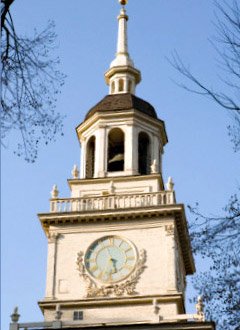 |
Robertson v. Princeton University: A Case Study
In September 2003 PRoactive Solutions, Inc. began a public relations campaign on behalf of the Robertson family's then one-year-old "donor intent" lawsuit against Princeton University. The potentially precedent-setting lawsuit had received only modest media attention, despite a year-long effort by a large New York City public relations firm. The apparent problem: Few news hooks presented themselves, as the case moved slowly through the courts.
PRoactive Solutions would take a different approach. Instead of waiting for news hooks to present themselves, PRoactive Solutions created a news hook by making the lawsuit the poster child for the issue of "donor intent," telling the national media and interested third-party organizations:
If the Robertson family wins its donor intent lawsuit against Princeton, it will underscore in a public and powerful way the ... legal and moral principle that charitable donations, when given and accepted for a specific purpose, may be used only for that purpose. If, on the other hand, the Robertsons lose their lawsuit and donors believe they have no recourse if donor intent is ignored ...[donors] will stop giving. The consequence could be tragic.
In short, a decision was made to bring the case before the court of public opinion. The courts would move at their own slow pace. In the court of public opinion we would call the plays.
Getting Results
Until Princeton settled with the family for $100 million in December 2008, weeks before the trial was scheduled to begin, PRoactive Solutions, Inc's strategy produced on-going, high-level results, generating news coverage and editorial support across the country and overseas, causing Princeton to repeatedly complain about the media onslaught and the university's chief spokeswoman to describe PRoactive Solutions, Inc. as "a very aggressive PR machine." [ University Business magazine, December 2007 ]
The media coverage included:
- Front-page stories in the New York Times, Wall Street Journal and Washington Post and feature stories in U.S. News & World Report and the U.S. News & World Report annual graduate school guide.
- Favorable columns by 16 nationally syndicated columnists, from the highly respected founding editor of Washington Monthly magazine, Charles Peters, a liberal, to conservative Cal Thomas, the country's most widely syndicated columnist. Editorials appeared in many additional publications, ranging from the left-of-center Newark Star-Ledger to the centrist Christian Science Monitor and USA Today to the conservative Wall Street Journal and Washington Times. None of them sided with Princeton.
- Start-to-finish coverage by th e Star-Ledger and Trenton Times; four national AP stories; several additional AP stories that moved on the New Jersey state/regional wire, and unbiased coverage by Princeton's student newspaper and alumni magazine.
- Television coverage on CBS, CNBC, CNN, FOX, and NBC and radio coverage on National Public Radio, Marketplace Radio, and other outlets.
- Numerous stories in trade and institutional publications covering philanthropy, nonprofits, higher education, legal issues and government service, including Advancing Philanthropy , AFSA (American Foreign Service Association) News, CASE Currents (magazine of the Council for Advancement and Support of Education) , Chronicle of Higher Education, Chronicle of Philanthropy, Foreign Service, Government Executive, Inside Counsel, Inside HigherEd, Legal Times, New Jersey Law Journal, NonProfit Times, Philanthropy, Philanthropy Journal, Philanthropy News Digest, Trusteeship and University Business.
- Twenty-one different op-ed page articles by lead plaintiff William Robertson and other family members, appearing in dozens of publications nationwide, including Forbes.com, the Los Angeles Times, Miami Herald, Newark Star-Ledger, and New York Post.
- Support from numerous third-party organizations, including the American Council on Trustees and Alumni, American Foreign Service Assn., Assn. of Fundraising Professionals, Center for Excellence in Higher Education, Center for College Affordability and Productivity and the Philanthropy Roundtable.
- Some 775,000 unique visitors to the RobertsonvPrinceton.org web site, which PRoactive Solutions, Inc. created and maintained.
- Coverage by dozens of bloggers, from general news blogs such as Instapundit.com to specialty blogs focused on philanthropy, higher education and the law.
Affecting Change
PRoactive Solutions strongly believes that change depends on results. This was evident in Robertson v. Princeton , as PRoactive Solutions' communications program thrust the case, and the issue of donor intent, into the national spotlight, putting Ivy icon Princeton University on the defensive.
The following media and third-party comments illustrate the effectiveness of the campaign:
"Robertson v. Princeton may be the most important case higher education has faced over the question of honoring the wishes of a donor." ( Wall Street Journal)
"But in recent years a few noisy disputes at major universities like ... Princeton have had a powerful effect on the fundraising game, prodding donors to become more vigilant and universities to become unusually careful ..." (New York Times)
"The case has crystallized a transformation in the fundraising culture of higher education, as philanthropists take a more active role in overseeing their donations." (Financial Times)
"Fallout from the case is expected to reach far beyond the Ivy League campus, dramatically reshaping nonprofit fund-raising and administrative practices." (Frederic J. Fransen, Executive Director, Center for Excellence in Higher Education, in the Philadelphia Inquirer)
"It has a significant impact in reminding individual not-for-profit institutions that one needs to comply ... with the intent of the donor." (Sheldon Steinbach, Senior Counsel, Dow Lohnes)
"The case has been hanging around for several years now and it already has sent shock waves through the nation's institutions of higher education and the non-profit community generally." (Nationally syndicated columnist Dan Thomasson, in the Seattle Post-Intelligencer)
"It's sad to see one of the greatest acts of philanthropy in U.S. history become the subject of bitter litigation. But it would be sadder by far if donors came to believe that their intentions count for nothing." (Nationally syndicated Boston Globe columnist Jeff Jacoby, in the Boston Globe)
"Needless to say, this has sent shock waves through the ranks of higher education. If the Robertson heirs should prevail in court, dozens of American colleges and universities - indeed, hundreds of institutions - would be advised to examine the relationship between their spending habits and their donors' intentions." (Columnist Phil Terzian, Providence Journal)
"Spurred in part by the publicity surrounding Robertson v. Princeton University ... development officers are reexamining their institutions' accountability measures and methods for greater responsiveness to donors." (CASE Currents, the magazine of the Council for Advancement and Support of Education)
"It's likely that the Robertson Foundation case will be the most important donor intent case of this decade. If Princeton wins, it will be a grave blow to the cause of donor intent." (Martin Morse Wooster, author of "The Great Philanthropists and the Problem of 'Donor Intent," in Foundation Watch)
"The battle between Princeton University and the family of its late benefactor Charles Robertson is shaping up to be a defining moment in American higher education." (Washington Times)
"A brewing legal case involving the renowned Woodrow Wilson School of Public and International Affairs is sending shockwaves throughout the charity industry, as well it should." (Tiffin [OH] Advertiser-Tribune)
"The outcome of the Princeton lawsuit, even though it is in state court, is likely to set a precedent in regard to 'restricted' gifts such as the Robertson endowment, either in favor of donor intent or in favor of the corrupt notion that donor intent is irrelevant." (Gloversville [NY] Leader-Herald)
"The suit has many college and university officials thinking hard about how they solicit big gifts, how they communicate with would-be donors about what the university and its priorities will look like down the road, and what is their obligation to donors' families after a donors' deaths." (Trusteeship,the magazine of Association of Governing Boards of Colleges and Universities)
The comments speak for themselves. PRoactive Solutions, Inc. speaks for its clients.
|


